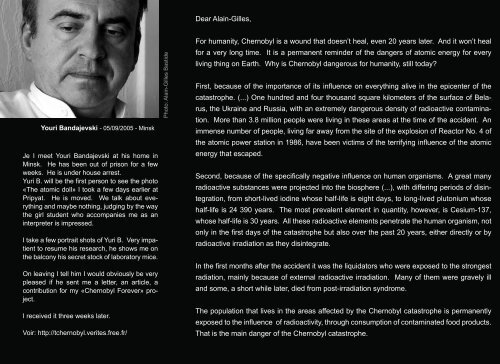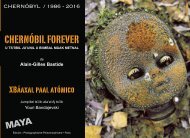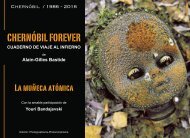TSCHERNOBYL FOREVER / ALLEMAND
Sie wollen auch ein ePaper? Erhöhen Sie die Reichweite Ihrer Titel.
YUMPU macht aus Druck-PDFs automatisch weboptimierte ePaper, die Google liebt.
Dear Alain-Gilles,<br />
Youri Bandajevski - 05/09/2005 - Minsk<br />
Je I meet Youri Bandajevski at his home in<br />
Minsk. He has been out of prison for a few<br />
weeks. He is under house arrest.<br />
Yuri B. will be the first person to see the photo<br />
«The atomic doll» I took a few days earlier at<br />
Pripyat. He is moved. We talk about everything<br />
and maybe nothing, judging by the way<br />
the girl student who accompanies me as an<br />
interpreter is impressed.<br />
I take a few portrait shots of Yuri B. Very impatient<br />
to resume his research, he shows me on<br />
the balcony his secret stock of laboratory mice.<br />
On leaving I tell him I would obviously be very<br />
pleased if he sent me a letter, an article, a<br />
contribution for my «Chernobyl Forever» project.<br />
I received it three weeks later.<br />
Voir: http://tchernobyl.verites.free.fr/<br />
Photo: Alain-Gilles Bastide<br />
For humanity, Chernobyl is a wound that doesn’t heal, even 20 years later. And it won’t heal<br />
for a very long time. It is a permanent reminder of the dangers of atomic energy for every<br />
living thing on Earth. Why is Chernobyl dangerous for humanity, still today?<br />
First, because of the importance of its influence on everything alive in the epicenter of the<br />
catastrophe. (...) One hundred and four thousand square kilometers of the surface of Belarus,<br />
the Ukraine and Russia, with an extremely dangerous density of radioactive contamination.<br />
More than 3.8 million people were living in these areas at the time of the accident. An<br />
immense number of people, living far away from the site of the explosion of Reactor No. 4 of<br />
the atomic power station in 1986, have been victims of the terrifying influence of the atomic<br />
energy that escaped.<br />
Second, because of the specifically negative influence on human organisms. A great many<br />
radioactive substances were projected into the biosphere (...), with differing periods of disintegration,<br />
from short-lived iodine whose half-life is eight days, to long-lived plutonium whose<br />
half-life is 24 390 years. The most prevalent element in quantity, however, is Cesium-137,<br />
whose half-life is 30 years. All these radioactive elements penetrate the human organism, not<br />
only in the first days of the catastrophe but also over the past 20 years, either directly or by<br />
radioactive irradiation as they disintegrate.<br />
In the first months after the accident it was the liquidators who were exposed to the strongest<br />
radiation, mainly because of external radioactive irradiation. Many of them were gravely ill<br />
and some, a short while later, died from post-irradiation syndrome.<br />
The population that lives in the areas affected by the Chernobyl catastrophe is permanently<br />
exposed to the influence of radioactivity, through consumption of contaminated food products.<br />
That is the main danger of the Chernobyl catastrophe.








